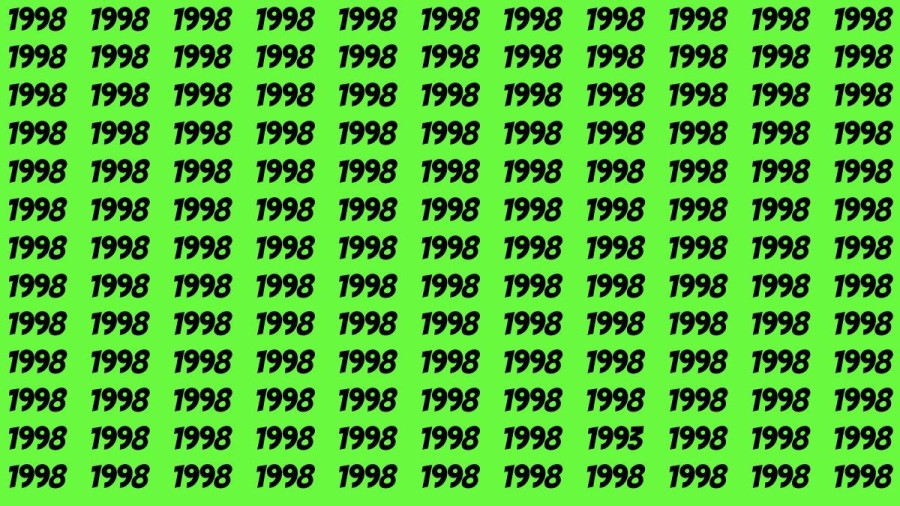Observation Brain Test: If you have Sharp Eyes Find the Number 1993 among 1998 in 20 Secs
by Sivasankari
Updated Apr 22, 2023

Brain Teaser
A brain teaser is a type of puzzle that needs to be solved. Solving brain teasers requires lateral thinking. You need to look at one puzzle from different perspectives. Archimedes, a Greek mathematician, was best known in earlier days as a brain teaser enthusiast because he was very well-versed in solving difficult puzzles with ease. To be honest, most of the brain teasers are tests of your IQ, where you are required to use your intelligence in solving the test.
How to Solve Brain Teasers?
Solving brain teasers can be a fun and challenging activity that requires creative thinking and problem-solving skills. Here are some tips that can help you solve brain teasers:
Read the question carefully: Brain teasers can be tricky and often involve a play on words. Therefore, it is important to read the question carefully to ensure that you understand the problem correctly.
Break it down: Once you understand the question, break it down into smaller parts. Identify the key elements of the problem and see if you can simplify the question.
Use logic and reasoning: Brain teasers often require you to think outside the box and use logic and reasoning to arrive at a solution. Try to eliminate impossible or unlikely scenarios and use deduction to narrow down your options.
Be creative: Sometimes, the solution to a brain teaser requires a creative approach. Don't be afraid to think outside the box and come up with unconventional solutions.
Practice: Solving brain teasers takes practice, so don't get discouraged if you can't solve a problem right away. Keep trying and practicing, and you'll improve your problem-solving skills over time.
Collaborate: Sometimes, solving a brain teaser can be more challenging if you do it alone. Consider collaborating with others and sharing your ideas and thought processes. This can help you arrive at a solution more quickly and efficiently.
Remember that brain teasers are meant to be challenging, so don't get discouraged if you can't solve them right away. Keep practicing, and you'll become a better problem solver over time.
Observation Brain Test: If you have Sharp Eyes Find the Number 1993 among 1998 in 20 Secs
Tackling these brain teasers requires you to think creatively and make yourself think of ways the issue can be solved easily. Brain teasers are quite simple if you crack the process of solving them by applying the various strategies that help in solving them. Thinking outside the box, for instance, will make it simple for you to discover the solution to this brain teaser.
If you are excited about solving brain teasers and want to try solving one, we have one you can try in the picture below. You have only a few seconds to solve this brain-teaser picture puzzle. Give your best and try to find it within the given seconds.

Observation Brain Test: If you have Sharp Eyes Find the number 1993 among 1998 in 20 Secs - Solution
We will discover the answer to the puzzle presented in the above article. We are all eager to know the answer, so let's get to it. Firstly, we will reveal the answer and then explain the reasoning behind it.
Don't worry if you were unable to solve the puzzle; brain teasers are meant to be fun, not stressful. If you stay calm and relaxed, you may even solve the puzzle before us. Our belief is that every puzzle has a solution.
While some puzzles may appear challenging, the answer may be simple. On the other hand, some puzzles may seem easy but require hard work to solve. Ultimately, the difficulty of a puzzle depends on the specific puzzle itself.
Upon careful observation of the above picture, we have arrived at the answer. The answer is not only for those who did not find it but also for those who predicted incorrectly.
It is okay to make mistakes as long as we learn from them. If you are curious to know the answer, continue reading the article. In every puzzle, there is a reason why a particular answer is correct.
While figuring out the answer, everyone might have their own reasons, but in the end, there will be only one correct answer with a specific reason. In the case of brain puzzles, this is particularly true. Let us take a closer look at why this answer is the correct one.

Observation Brain Test: If you have Sharp Eyes Find the Number 1993 among 1998 in 20 Secs - FAQ
The brain teaser is described as a type of puzzle that needs to be solved.
Any problem, whether it is a brain teaser, a puzzle box, or a riddle, requires lateral thinking to complete.
A brain teaser helps us to improve our thinking abilities and stay focused on the solution we are finding, as it helps us to think and develop outside of our comfort zone.
Finding a solution often requires attacking a problem from a number of different angles, whether direct or indirect.







